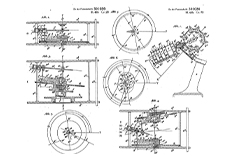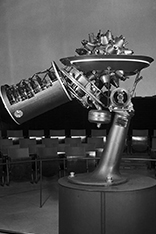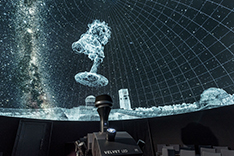Content
100 years projection planetarium

DE391036
Reaching for the stars
The DPMA congratulates its neighbour in Munich, the ![]() Deutsches Museum: 100 years ago, on 21 October 1923, the world's first projection planetarium was presented there. The inventor of the artificial starry sky was Walther Bauersfeld, who filed a patent application for his 'device for projecting stars onto a spherical projection screen' in 1922 (
Deutsches Museum: 100 years ago, on 21 October 1923, the world's first projection planetarium was presented there. The inventor of the artificial starry sky was Walther Bauersfeld, who filed a patent application for his 'device for projecting stars onto a spherical projection screen' in 1922 ( ![]() DE391036 (1,15 MB)).
DE391036 (1,15 MB)).
Oskar von Miller, the founder and first director of what is still the world's largest technical museum, had already approached the Carl Zeiss company in Jena in 1913. He had a kind of "rotating star sphere" in mind.
Poster gallery of inventions
The first projection planetarium is also represented with its own ![]() Poster (1,1 MB) in the Gallery of Inventions, which can be obtained from the DPMA.
Poster (1,1 MB) in the Gallery of Inventions, which can be obtained from the DPMA.
"Planetary machines", also called "orrery" (after an English earl who received one in 1713), have existed for centuries. Even in ancient times, there were devices for calculating stellar constellations such as the mechanismus of Antikythera. But an authentic simulation of the dynamic starry sky was a completely new idea. Whereas in an observatory the view of the stars is strongly dependent on the weather and only shows the current constellation, the planetarium was to simulate the unobstructed view of space at different locations and times as well as the movements of the planets.
Wilhelm Bauersfeld, born in Berlin in 1879, had initially worked on aircraft engines after studying mechanical engineering before becoming one of the managing directors at Carl Zeiss in Jena in 1908. When von Miller approached Zeiss, Bauersfeld threw himself into the work. At first, they thought about a hemisphere with holes for the stars that could be illuminated from the outside. But then the concept of working with projections emerged.
After the end of the First World War, Bauersfeld and the civil engineer Franz Dischinger took up work on this idea again. The first task was to create a suitable dome. They developed a construction method for support-free concrete roof shells, which today is called the "Zeiss-Dywidag system" and was a precursor of the shotcrete construction method. Zeiss applied for a patent for this construction principle as the "purlinless reinforced concrete barrel roof"( ![]() DE431629).
DE431629).
Bauersfeld, who also taught as a professor at the University of Jena, constructed the complex technical heart of the planetarium in parallel. The patent specification (DE391036) clarifies the principle: the artificial night sky with about 4500 stars is created by several projection devices arranged around the centre of the dome. While the fixed starry sky rotates around the world axis, separate mechanisms simulate the movement of the sun, moon and planets.
This world's first planetarium projector was developed and built in Jena between March 1919 and July 1923. In the same year, it was presented to the public in Munich - but initially only briefly. After a few test screenings, it went back to Jena. It was not until 7 May 1925 that the projection planetarium began permanent operation in the Deutsches Museum.
Today, the first projector is itself an exhibition object in the history of technology. Its current successor, the Zeiss Skymaster ZKP4, not only shows planetarium guests a perfect Munich night sky, but can also simulate, for example, the stars above any point on Earth, or at a point in time 1000 years ago, or a constellation in the distant future. The light-fibre star projector even enables virtual journeys to the limit of the observable universe billions of light years away.
After the Second World War, Bauersfeld helped to build up the West German Zeiss-Werke in Oberkochen and taught at the TH Stuttgart. He died in 1959. Today there are thousands of projection planetariums worldwide. The Munich Planetarium is still an important attraction of the Deutsches Museum, which is currently celebrating its anniversary with a special exhibition.
Text: Dr. Jan Björn Potthast; Pictures: DEPATISnet, Deutsches Museum, Deutsches Museum/Reinhard Krause
Last updated: 19 May 2025




Not only protecting innovations
Social Media